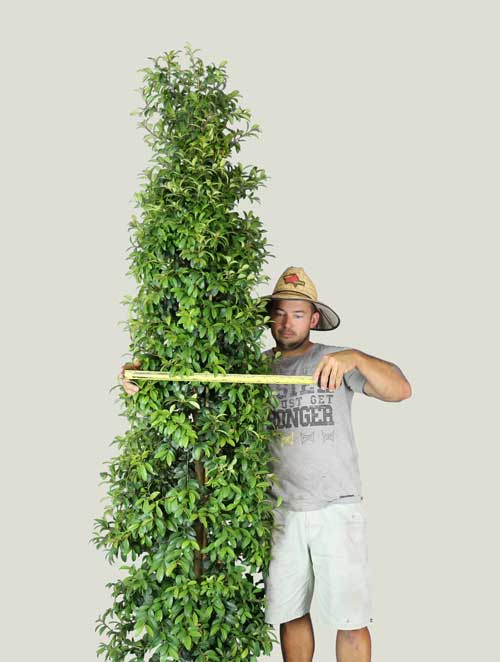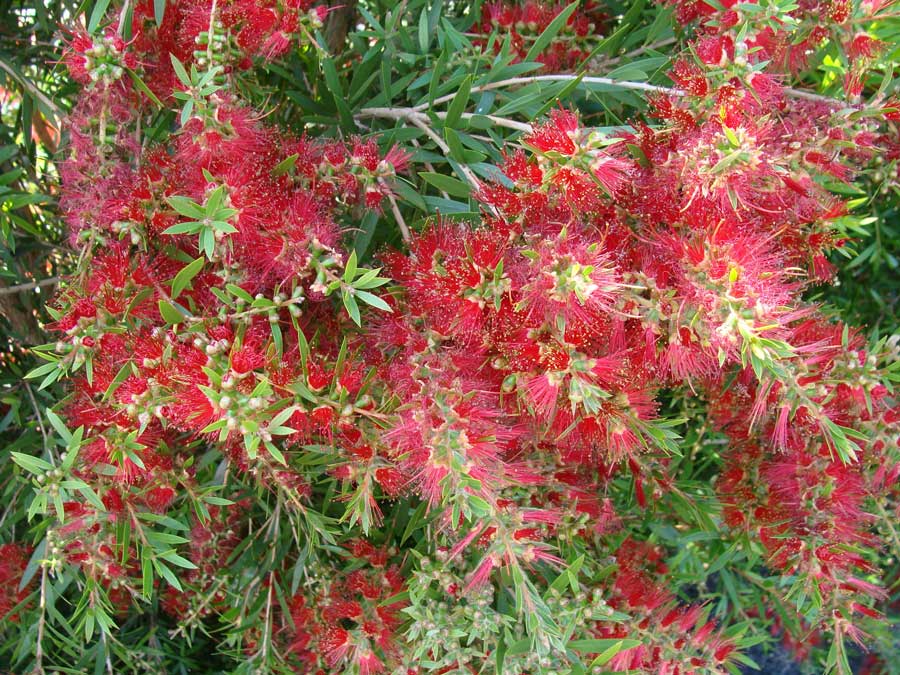Are you wondering about the best native trees to plant in a small garden? Selecting suitable trees for smaller spaces can be quite a challenge, especially when you have a specific space you’re trying to fill that’s bigger than a shrub but smaller than an average tree.
In this article, we’ll guide you through choosing the right native evergreen trees for your small garden, whether that’s a grafted standard, a mallee, a columnar shrubby tree, or a dwarf variety.
A small space is never a reason to neglect trees. Look how many trees the south western courtyard at the Shrine of Remembrance in Melbourne’s CBD manages to squeeze in.

Understanding the Australian Climate and Soil Conditions for Your Small Native Trees
Australia’s climate is as diverse as its landscape, ranging from tropical in the north to temperate in the south, with arid conditions dominating the interior and Mediterranean conditions out west. This diverse climate greatly impacts the types of plants that thrive in different regions.
Soil types in Australia also vary widely, from sandy soils along the coast to clay soils inland. Sadly, our urban soils are often even worse than the poor soils that some native plants have been dealing with for millions of years.
The type and quality of soil in your garden significantly influences water and nutrient availability, which in turn affects your selection of small native tree. Some native small trees prefer well-drained sandy soil, while others thrive in heavier clay soils.
Most trees, especially flowering trees, attract native wildlife including marsupials, insects and nectar eating birds. Even in smaller gardens and small spaces within larger gardens, your efforts can make a genuine difference for biodiversity by creating a part of the interconnected wildlife corridors that exist from one eco-friendly garden to another.
Choosing the Right Trees for Your Small Garden
The correct tree can create a focal point, provide shade, and even increase property value. Conversely, a poor choice can lead to overcrowded planting, impede other plants’ growth, or require costly and time-consuming maintenance.
There’s never a better time to invest time into choosing a tree than before you plant it in the ground.
How to Choose the Right Native Tree for Your Small Garden
Several factors should be considered when choosing trees for your garden. These include the tree’s light, nutritional and water requirements, soil preferences, growth rate, mature size, and potential for attracting wildlife.
You want to plant the right tree in the right place, along with companion plants that all complement each other’s needs. Is your new tree going to shade out your veggie patch, decreasing yields?
Best Small Trees for Native Gardens in Australia
Now let’s dive into the specifics of various tree species suitable for small gardens in Australia. We’ll provide practical advice on caring for and maintaining each tree type, ensuring they add beauty to your garden for years to come.
Straight and Narrow™ Syzygium australe ‘SAN01’ PBR
This cultivar is a unique, narrow-growing shrub perfect where you have a bit of height but restricted horizontal space, such as courtyards and balconies. It features deep green foliage and white flowers, followed by red berries. It’s excellent for hedging and screening and grows up to 8m high and just 1-1.5m wide. It’s pest and disease resistance, and features incredible glossy green foliage, fluffy white flowers, and vibrant pink edible berries.
This lilly pilly is one of the best native tree options for small spaces, including courtyards.
Eucalyptus caesia
Eucalyptus caesia, commonly known as silver princess, is an excellent choice for small gardens. This small eucalypt is admired for its weeping habit, silvery foliage, red and white bark, and stunning pink or bright red flowers which attract birds. It typically reaches heights between 6-8m, making it a perfect fit for smaller spaces.
Caring for a Eucalyptus caesia involves ensuring it’s planted in a spot with full sun exposure and well-drained soil. Regular watering during dry periods will help this tree thrive, while occasional pruning can see perfect tree maintain its shape and size.
With that being said, tree pruning in general is often best left for a qualified arborist. This is because of safety reasons, tree health resons, and amenity reasons. Poor pruning can lead to undesirable growth responses from the tree.
This is an even smaller “tree” (technically a mallee) than another eucalypt that often gets recommended for small gardens, Corymbia ficifolia which can be seen with vibrant, red, yellow or rose pink flowers.
Acacia, Grevillea, and Banksia Standards
These popular Australian native plants have been grafted and trained as standards—meaning they boast a single, straight stem with a rounded ball of foliage at the top. Typically standing around 1m tall, these plants are perfect for adding height and interest to a small garden.
They can give the appearance of flowering trees without the main “trunk” ever growing taller. Simply prune branches back to a fork to maintain the natural shape, and prune out a few older branches every few years.
Elaeocarpus reticulatus
Commonly known as blueberry ash, this tree exhibits a lovely columnar growth habit and produces white or pink bell-shaped flowers followed by bright blue berries. Depending on conditions, it can grow anywhere from 3-15m tall.
Leptospermum petersonii
Known as the lemon-scented tea tree, this small tree is noted for its fragrant, lemon-scented leaves and beautiful white or pink flowers. It typically grows to around 5m tall.
Backhousia citriodora
Commonly referred to as lemon myrtle, this tree is prized for its lemon-scented leaves, which are often used in cooking and tea. It typically grows between 3-8m tall.
Melaleuca nesophila
Also known as pink melaleuca or showy honey-myrtle, this small tree is admired for its round shape, dense foliage, and beautiful pink or purple flowers. It typically grows to around 5m tall.
Ceratopetalum gummiferum
Known as New South Wales Christmas bush, this tree is famous for its bright red calyces that resemble flowers and appear around Christmas time. It typically grows to 6m tall but can reach up to 10m in the wild.
Brachychiton bidwillii
Known as little kurrajong, this small tree is admired for its bell-shaped flowers that range from pink to red in colour. It typically grows between 4-5m tall.
Slim™ Callistemon viminalis ‘CV01’ PBR
This unique cultivar has a narrow growth habit, making it ideal for tight planting areas. It produces classic bottlebrush flowers in spring, summer, and autumn. It’s highly resistant to myrtle rust and can tolerate temperatures down to -6 degrees Celsius without leaf burn. It grows up to 3m high and 1.3m wide and is suitable for use as a screen, hedge or feature plant. It can tolerate both drought and wet feet, so it’s perfect for spaces that get flooded.
This bottlebrush tree works great as a hedge or as a standalone specimen. It’s disease-resistant and blooms abundantly in spring.
Tips on Planting and Caring for Your Trees
Planting and caring for trees of any size involves more than just digging a hole and watering. Here’s a step-by-step guide to help you plant your selected trees:
- Choose the Right Location: Ensure the site suits the tree’s requirements, such as sunlight, soil type, and space for growth.
- Prepare the Ground: Remove any weeds from the area. Amend heavy clays with gypsum and organic matter, or sandy soils with kaolin clay, quality hydrogels and/or organic matter. Consider whether turning the soil is practical or necessary.
- Dig the Hole: The hole should be twice as wide as the tree’s root ball but no deeper. This allows the roots to spread out without sinking the tree too low into the ground. Avoid glazing heavy clays, instead leaving a rough, jagged edge to your holes.
- Plant the Tree: Place the tree in the hole, ensuring it is standing straight. The top of the root ball should be level with the ground surface. Spin it around until the “good side” is facing the place most people will be viewing it from.
- Backfill the Hole: Fill in the hole, firming the soil gently around the base of the tree to remove any air pockets. Avoid burying the stems – we want roots in the ground, and leaves and stems in the air.
- Water Generously: Water the tree thoroughly after planting to help settle the soil.
Now that your trees are planted, here are some tips to ensure their healthy growth:
- Watering: Regular watering is crucial, especially in the first few months after planting. However, avoid overwatering as this can lead to root rot.
- Mulching: Apply a layer of mulch around the base of the tree to conserve moisture, suppress weeds, and regulate soil temperature. Avoid piling mulch against the trunk.
- Pruning: Prune your trees as needed to maintain their shape and remove dead or damaged branches. Pruning is an art, so engaging the help of a qualified arborist can help you foster a healthier and more beautiful plant. It’s especially important to get the formative pruning right in the first couple of years, which will set the stage for the rest of your tree’s life.
- Feeding: Apply a slow-release fertiliser in spring to promote growth and improve the overall health of the tree.
Conclusion
Australia is home to a variety of native trees that are perfectly suited to small gardens. From the weeping habit of Eucalyptus caesia to the narrow growth of Slim™ Callistemon and the glossy leaves of Luscious® Tristaniopsis, there’s a tree for every garden.
Remember, while the trees listed in this article are excellent choices, they’re just the tip of the iceberg. Don’t be afraid to explore other dwarf native trees that could add beauty and variety to your garden. After all, the best part of gardening is discovering new plants and watching them flourish under your care.
So, here’s to happy gardening and finding the perfect trees for your small space!


